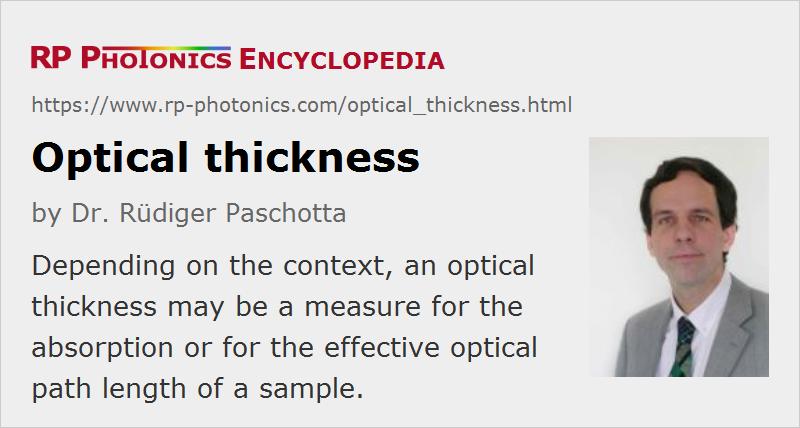Definition
The origin of the optical thickness: In the process of preparing a film, in addition to the appropriate film material and deposition process, the thickness of the film deposition process is precisely controlled.
The concept of thickness has three: geometric thickness, optical thickness and quality thickness. The geometric thickness is represented by the physical thickness or actual thickness of the film film layer; the product of the geometric thickness and the refractive index of the film film layer is referred to as an optical thickness; the quality thickness is defined as the mass of the unit area, and if the density of the thin film film layer is known, It can be converted into a corresponding geometric thickness.
In general, the error of the thickness of the film is controlled within 2%, sometimes 5 to 10%. Monitoring of film thickness must be within the permissible error range.

The optical thickness and physical thickness conversion relationship between the film is: the optical thickness = physical thickness * nn is the dielectric refractive index (light from the medium 1 injection medium 2, the incident angle and the body of the refraction angle) The refractive index of the medium 2 relative to the medium 1 is called.
Measurement method
The thickness of the film should be monitored during film deposition, first possible to measure the thickness of the film. Methods of film thickness online measurements are mainly: measuring resistance, mass, reflective transmissive spectrometry, and elliptical polarization spectrometry, etc., which makes monitoring of film thickness by measuring these physical parameters.
In the above method, the resistance method is most easily achieved, and the quality method is the most widely used, and the optical monitoring method is mainly used in the field of optical coating.
Electrical resistance method
Measuring the thin film resistance change to control the thickness of the metal film is the simplest film thickness monitoring method. To measure the thin film resistivity with the Wheatton Bridge as an example, this method can measure the resistance from 1 ohm to several hundred megawn, if the DC amplifier is added, the resistivity has a control accuracy of 0.01%.
However, as the thickness of the film increases, the resistance reduction is slower than expected, the cause of the film layer is the boundary effect of the film layer, the structural difference between the film and the block, and the effect of residual gas. Therefore, it is difficult for the accuracy of film thick monitoring with this method to be higher than 5%. That is, the resistance method is still used in electrical coating.
method and apparatus
In a classic film system, no matter how many media materials are used, their thickness is a normal, which is one quarter. Wavelength or its integer double thickness. This is largely due to the traditional analytical design method of 1/4 wavelength or an integer, which is undoubtedly, which is convenient for preparation and monitoring of the thickness of 1/4 wavelength or integer. Successfully used to monitor these membranes. However, as the application of the optical film is increasing, the characteristics of the film continue to put forward new requirements, and the classic film system can no longer meet the requirements, but the new film system of any thickness must be found. Using electronic computer automatic design technology, in order to increase design parameters, the thickness of each layer is usually used as correction parameters, and thus the various film systems obtained, and its thickness is almost unregulated.
The thin film system of any thickness has many excellent optical properties, but a lot of difficulties have been made to thickness monitoring, and the monitoring method of any thickness is mainly: quartz crystal monitoring method, single wavelength transmissive (reflection spectrum) method, Wide spectral scanning method, elliptical polarization spectroscopy. Among them, the quartz crystal monitoring method has been introduced, and it will not be described here.
